War is the negative reference point for peace narratives, and peace is the positive reference point for war narratives. As such, there is an intimate relationship between peace narratives and war narratives. War photographers, for example, visualize peace negatively by showing its absence. They do so, not to celebrate war but to show, in photographer Don McCullin’s words, that “war is bad” and that it should be abolished as a means of dealing with conflict.
Because of the intimate relationship between war narratives and peace narratives, we would like to introduce the project Visualizing War: Interplay between Battle Narratives in Ancient and Modern Cultures at the University of St Andrews.

The project asks:
“How do war stories from different media, communities and historical periods both shape and differentiate themselves from each other? How do their interactions reflect and shape broader attitudes to war? And how do the attitudes and ideologies which they generate influence the ways in which people think, feel and behave in their day-to-day lives?”
The focus on people’s day-to-day lives resonates with our interest in everyday peace (or colloquial peace or minimalist peace), i.e., people’s resistance to the logic and dynamics of violence by, in Roger Mac Ginty’s words, “eking out safe space in a [violent] conflict context” thus “allowing a façade of normality to prevail.” Everyday peace requires “considerable innovation, creativity and improvisation.”
Everyday peace requires and builds capacity in individuals; this capacity, in turn, is relevant far beyond specific everyday practices in the sense that it carries with it the possibility of changing the overall context within which such practices occur.

Everyday peace coincides with the Visualizing War project’s “ultimate goal” of “build[ing] capacity in individuals and groups to harness narratives of war to prevent or mitigate against the effects of future conflict.”
The principal investigators of the Visualizing War project are Alice König and Nicolas Wiater.
Some of the project’s research interests are introduced in this podcast.
Peace Photography will be introduced in this podcast in early autumn.
